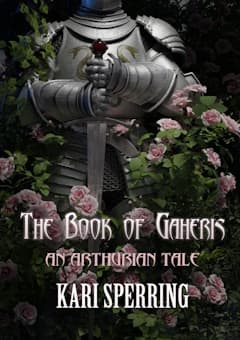
The Book of Gaheris: An Arthurian Tale by Kari Sperring
(Newcon Press, 2023)
Reviewed by David Lascelles
The legends of Arthur and the Knights of the Round Table are among the most well-known tales in Europe and the US, if not wider. There have been many interpretations throughout history and the tales have contributed significantly to the tropes of ‘knights in shining armour’ that we know and love today.
I’m willing to bet that everyone can name at least some of the knights. They’d certainly recognise Arthur, Lancelot, Gawain and Galahad.
These knights are not the heroes of this book. They appear, but only as cameos. Here, we are looking in detail at the lesser-known knights, in particular Gaheris.
Gaheris is one of the ‘Orkney brothers’ of which Gawain is the eldest, the sons of Lot of Orkney and his wife Morgause. He was Gawain’s squire as a child and is, by the start of this book, a full adult knight and married. A rather minor, background character in most of the stories. Apart from one tragic tale…which I won’t share here because…SPOILERS!
Oh, OK, I guess you could go and read the original tale which has been around for a while, but be warned that it is tragic.
Suffice to say that Gaheris is not one of the ‘cool kids’ in Arthurian myth. Which is what makes this book so fascinating. It is a chance to delve into some of the classic tales from a different angle as well as examining some of the characters in a more modern light. Gaheris here is especially interesting as he comes across as having quite high imposter syndrome. He never seems to consider himself a good knight, despite being regarded highly by other characters. Not unexpected given the calibre of the people he compares himself to—specifically Arthur, Lancelot and Gawain. This is a refreshing approach to have for a male hero in what is effectively a fantasy novel.
There are four novellas here, each telling a different story from a different point of view, starting with the aforementioned tragic tale. The common feature is Gaheris himself, of course, but overall they examine a range of characters that serve to add depth to the original tales. For example, one of the novellas, Rose Knot, is from the point of view of Llinos of Kinkandedron, wife of Gaheris’s brother, Gareth. This story works to enrich the female characters in the myths, making them more than just the ‘sexy lampshades’ they are usually portrayed as. There is also more light cast on characters such as Safere, the Moor who appears in some of the stories, and several other knights who barely feature in the traditional tales.
Sperring’s prose is clean and light and tells the stories well. The first-person approach works well here with each point-of-view character coming across as a well-rounded and with a clear personality. One flaw from my end was that I became aware while reading of how woefully ignorant I was of Arthurian myth. I knew the main stories and characters but a number of times I had to make use of Google to look up the names of characters and see where they appeared in the original tales. Ultimately, in terms of enjoying the stories, you don’t need to know this information. You can happily follow what is going on from the way the stories are structured. However, if you are a curious nerd like me and aren’t familiar with the tales, you may want to be prepared to do some reading.
Occasionally, the stories approach soap opera status in terms of complications in relationships and the problems these cause. In at least one of the stories, we have epic melodrama. However, this is all in keeping with the source material.
Overall, this is a worthy book both for casual readers of fantasy and serious Arthurian fans who might want a different view of Camelot.
Review from BSFA Review 21 - Download your copy here.
